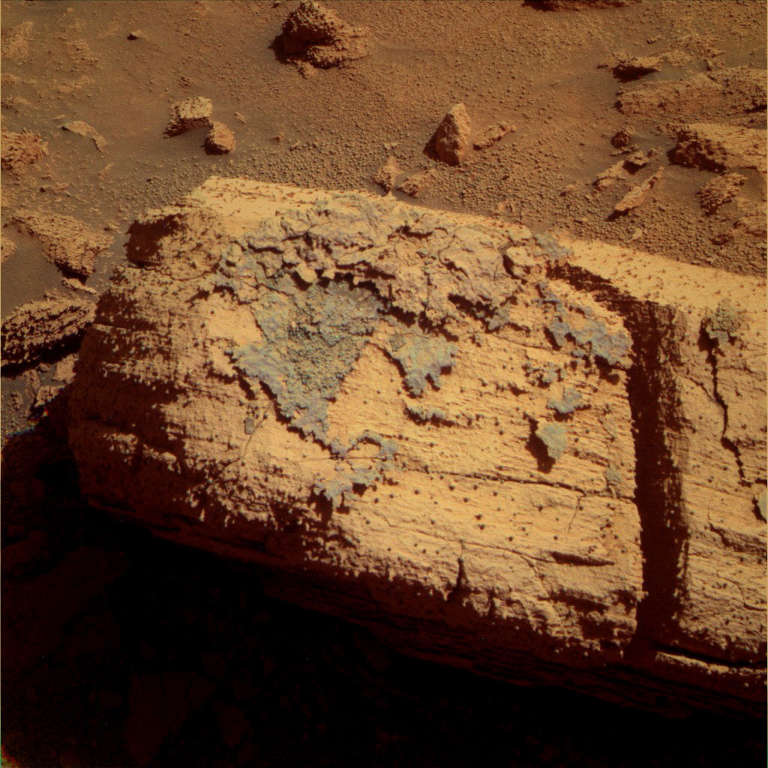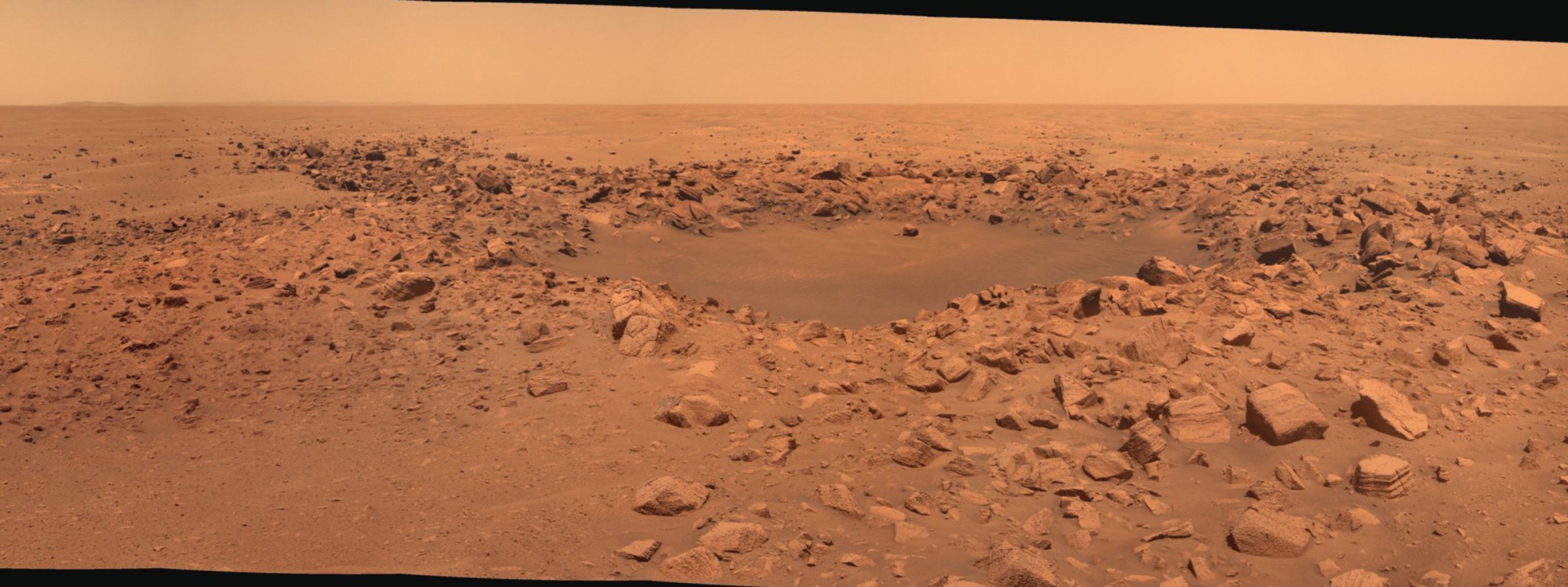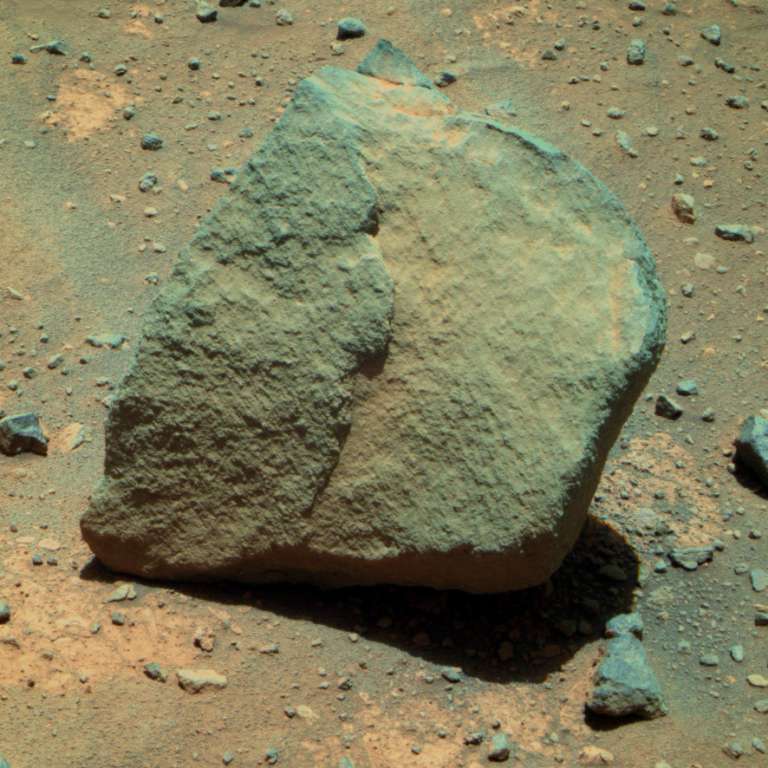Emily Lakdawalla • Mar 05, 2010
LPSC, Day 3: Opportunity, and what the heck is Marquette?
I wrote earlier about some results from Spirit reported at this year's Lunar and Planetary Science Conference in Houston, Texas; here are the rest of my notes on rover-related talks, from Opportunity's site on the opposite side of Mars. And now that I'm at home and in front of my big screen, I can toss in some eye candy to help you work your way through the technical stuff.
First up was Steve Squyres, giving his overview of "Recent Scientific Results from Opportunity's Traverse Toward Endeavour Crater, Meridiani Planum, Mars." Usually by the third day of the conference, people are really beginning to struggle to make it to the session rooms by the 8:30 start time, but Steve's talk was reasonably well attended.

He asserted that the most interesting results from Opportunity's past year of work were the three iron meteorites Block Island, Shelter Island, and Mackinac; the lone rock named Marquette Island; and Opportunity's current location, Concepción crater. The LPSC audience is a funny one -- lots of very smart scientists, not all of whom are paying very close attention to anything that is not under their noses; so Steve got a chuckle out of the audience when he posted an image showing Opportunity's path as of sol 2020 or so, after the team had driven the rover westward, "jammed on the brakes," as Steve put it, and returned to view Block Island.
He summarized the observations of the three meteorites. Here are my notes on his summary, taken as rapidly as I could, but which should still be regarded as paraphrasing rather than direct quotes: "They are all extensively weathered and heavily pitted. Block Island is the least weathered. We think this happened after they got to Mars. He noted that Block Island was substantially more massive than the rover, 60 centimeters across and about 240 kilograms in mass. He compared them to a photo of the Willamette meteorite, an Earth example, also heavily pitted. He said their working hypothesis for the pits is that sometimes meteorites contain iron sulfide inclusions. This comes in contact with water, it makes sulfuric acid, and it eats away at the meteorite. Is the same thing going on on Mars? All three meteorites are the same geochemical type. We suspect they are all part of the same parent body. We looked very hard for compositional inhomogeneities between the three and we found no evidence for them.
here are places where there are blueberries that are too large to saltate that are in pits on top of the meteorites, so we think they were buried and then exhumed. Under investigation is the relative importance of physical and chemical weathering."
On to Marquette Island, and more paraphrased notes: "Marquette island was pretty cool. We have been looking for a long time for Martian rocks that are pieces of ejecta from faraway craters. We see lots of local bedrock, a surprising number of meteorites, but only twice have we found igneous rocks that we think are ejecta from distant craters. [Other one is Bounce Rock.] Took us 2000 sols to find another one. Surface is crystalline up to a few millimeters in size, very nicely preserved. This is a pretty crisp, clean igneous rock. Definitely mafic, but does not match any SNC [that is, Martian meteorite] or any rock that has been observed to date by either Spirit or Opportunity. Bounce rock did match a SNC. Mössbauer analysis reveals lots of olivine, some pyroxene, substantial plagioclase, no layering, no sedimentary texture. We interpret it to be ejecta from some distant crater. To what extent could this be representative of the protolith from which Meridiani sediments were derived? When you do geochemical modeling, take current Meridiani sediment composition and run it backwards, it does not match composition of Marquette Island. Meridiani sediment probably derives from many different parent lithologies."

As for Concepción, "We believe this to be probably the freshest crater that either rover has seen or will ever see. Rocks show polygonal fractures. [Chocolate Hills] is one of the strangest things we have seen on Mars. You see North America, Panama, Greenland {the audience laughs} no, just kidding! Was this originally a fracture fill? May simply be a coating. If you look carefully, you see it's got a lumpy texture. It's wall-to-wall blueberries. Don't know what's going on here. Multiple working hypotheses. One is it's impact melt -- what happens when you take sulfate-rich sandstone, rich in hematite concretions and you melt it? Another is it's a fracture fill produced by water moving through rocks. Another is that these blueberries just precipitated in place like this. [Moving on to crater morphology,] Blocks of ejecta lie atop aeolian ripples, so formed since last episode of ripple migration. Under investigation at Concepción crater: Just about everything, it's a work in progress."
He wrapped up by showing a view of the path ahead, promising phyllosilicates to be found in the rim of Endeavour crater based on work by James Wray. He showed an Opportunity panorama with some distant hills on the horizon to prove the crater rim was already visible, to oohs and aahs from the audience. In the Q and A session, he was asked when they'd get to Endeavour; he said he'd learned long ago not to predict that, that it all depends on how kind Mars is to them. If Mars is kind, it'll throw various distracting things into their path, like the meteorites and Marquette, and it'll take them longer to get there.


Later in the same session, Dave Mittlefehldt gave a presentation devoted exclusively to "Marquette Island, a distinct mafic lithology discovered by Opportunity." But, he said as he started his talk, he was editing its title to "Marquette Island, a distinctly odd mafic lithology..." He spoke of its "hackly" looking surface (a term really in use by geologists to describe a jagged fracture surface) and said "there's no clear evidence of igneous texture, which suggests it's possibly a clastic rock." Wait. What? That's not what Steve said! But the rover team is a large and diverse one. Either there's a new consensus that Steve wasn't aware of, or there's disagreement; I can believe either one easily. "It's a very olivine-rich rock, 70% olivine, 24% pyroxene, smidgeon of nanophase oxide [6%], there may be surface dust. Ferric to ferrous iron ratio is very low, .06, so it is a very fresh, unaltered rock. APXS results: interior has very high magnesium content. RAT holes bored in substantially increased measured magnesium. Sulfur content is very low, much lower than for soil, lower than for cobbles, much lower than for outcrop materials. Marquette is distinct from Adirondack class basalts; distinct from meteorites; it is a new Martian lithology. But wait! There's more!"
The next bit involves details of x-ray spectrometry that I only vaguely understand, but I took notes as best as I could. "APXS results showed higher 'Compton scatter peak' than expected. This indicates silica in the rock is bound to more oxygen [than we are modeling] -- Compton scattering is sensitive to light elements in the target region. Marquette has statistically higher Compton peak to Rayleigh peak ratio; this can be explained by adding 15 weight percent equivalent oxygen. Must be a light element adding to scattering. Compton peak is sensitive to carbon, nitrogen, and oxygen in the rock, which behave similarly in APXS; hydrogen is invisible to this process. Depth of information is 100 microns, much deeper than APXS major element analysis records. Mössbauer analysis shows that excess oxygen in the form of as Fe2O3 cannot explain it. So the most plausible suspects to explain light element excess are carbonates and clays."
Mittelfehldt finished: "In my opinion the texture suggests it's a clastic rock. The iron minerals are primary igneous minerals," that is, they are grains eroded from an originally igneous rock, re-cemented into a clastic rock. "The major element chemistry is unique. It is interpreted as clastic sediment of primary igneous mafic minerals cemented by alteration phases produced elsewhere, maybe including carbonates and hydroxyl-bearing phases like clays or kaolinite. It's not a chemical cement." Make of that what you will!
Since I'm discussing Opportunity I'll throw in one more Opportunity talk from the previous day, by Matt Golombek, who is an engaging speaker and a wonderful guy but talks too darn fast for my notes to be of any quality. I've summarized the gist of his talk in the blog before. So I'll just add a few notes regarding blueberries near Meridiani craters. "Opportunity has been traversing for 20 km across ripples varying from centimeter to meter size. They are covered by a carapace of 1-4-millimeter-size blueberries that eroded out of sulfate rocks. We've gone by two fresh crater clusters that appear younger than the latest phase of ripple migration at Meridiani. Resolution is a very young crater, ejecta superposed on ripple, ejecta not planed off. Adventure crater superposed on north-south ripples, but east-west ripples are superposed on them. Dark pebbles are preferentially found at craters, likely a lag of impactor-derived fragments. [Somewhere in here he showed a HiRISE image of Opportunity at Concepción and cracked a joke about Opportunity clearly being superposed on the ripples and therefore being the stratigraphically youngest thing in the scene.] Concepción crater is about half-filled, about a meter thickness, with sand so there has clearly been sand that has migrated across this zone, it's just this ripple has not been active. But where have all blueberries gone? Rocks are chock-full, none seen on surface." He moved on to a more distant crater not visited by Opportunity, Ada, which is stunningly beautiful as seen in HiRISE images. "This crater formed after ripple migration. Other Ada secondaries are clearly superposed on ripple structures. Fresh rayed craters like Ada are devoid of hematite. The air blast from cratering event dispersed blueberries," blasting them away, leaving their ejecta lacking blueberries and appearing as holes in the TES hematite map.
Support our core enterprises
Your support powers our mission to explore worlds, find life, and defend Earth. You make all the difference when you make a gift. Give today!
Donate

 Explore Worlds
Explore Worlds Find Life
Find Life Defend Earth
Defend Earth

